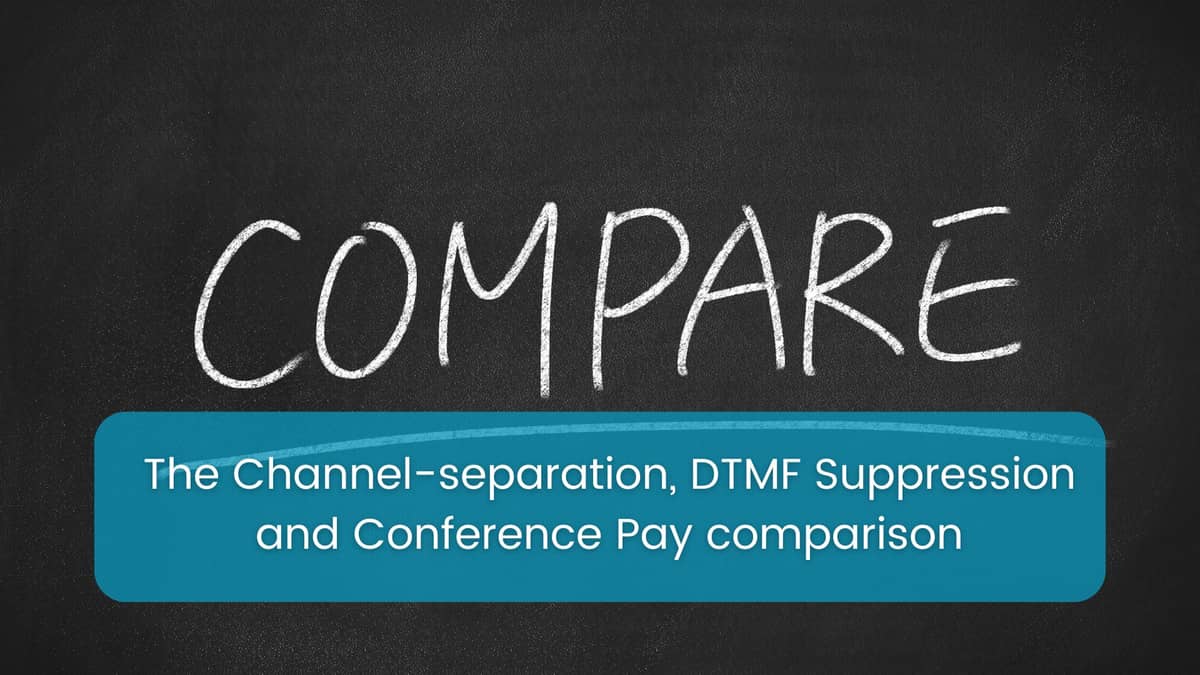
Secure Phone Payment Capture: Payment Methods | Paytia
At-a-glance differences
Channel Separation: Disconnects the audio path during card entry. Agent hears hold music and progress messages; customer hears instructions. Removes any chance of sensitive data being spoken or overheard; keeps full call recordings without gaps.
DTMF Suppression: Agent stays on the call. Customer enters card details via keypad; tones are masked so nothing sensitive can be heard or captured. Keeps human interaction live throughout.
Conference Pay: Agent uses their phone system’s conference feature to add Paytia to an active call. Agent authenticates with keypad, brings customer back, then presses Start Capture in the Agent Capture Assist UI. Agent remains on the call; both parties hear guided prompts while the customer enters PAN + #, MMYY, and CVV/CVC. Paytia processes the payment and drops from the conference; the agent and customer continue.
When to use each
Choose Channel Separation when you require maximum protection against verbal disclosure, a guaranteed continuity of call recording, and a controlled, consistent experience across many agents/sites without extra training.
Choose DTMF Suppression when you prioritise continuous conversation and agent support during payment, but still need to ensure keypad tones cannot be heard or recorded.
Choose Conference Pay when you want to activate secure capture mid‑call using your existing telephony, without integrations. Perfect for mixed or legacy PBX estates, outsourced teams, or where agents need a rapid, repeatable way to trigger Paytia without changing their dialler or call flow.
Operational flows (high level)
Channel Separation
DTMF Suppression
Conference Pay
Ready to Secure Your Payment Processing?
Paytia provides secure, PCI DSS compliant payment solutions that protect your business and customers. Learn how we can help you reduce compliance burden while improving security.
Compliance and risk
Channel Separation: PCI DSS scope reduction equivalent to the other methods. Sensitive data is never present in agent audio or recordings during entry, eliminating pause/resume, secure rooms, and many staff controls.
DTMF Suppression: PCI DSS scope reduction equivalent to Channel Separation. DTMF tones are masked so no card data is audible or recorded while the agent stays connected.
Conference Pay: Lower PCI DSS scope reduction compared to the other two methods because agent and customer are on the same call leg in conference mode, so the agent can hear keypad tones. Means more controls apply versus full separation or tone masking.
People, process, and technology impact
People
Channel Separation: No training required; consistent voice prompts provide built‑in guidance.
DTMF Suppression: Minimal training; agents continue their normal conversation style.
Conference Pay: Simple agent steps (hold, conference, agent ID, Start Capture). Works well for outsourced or mixed‑experience teams.
Process
Channel Separation: Removes verbal repetition risk; maintains full call recordings without gaps.
DTMF Suppression: Keeps conversation flowing; reduces abandoned payments from uncertainty.
Conference Pay: Adds a repeatable trigger Paytia mid‑call step with no dialler change.
Technology
Channel Separation: Best where you want a standardised, zero‑training experience across sites.
DTMF Suppression: Fits existing IVR/contact centre flows with minimal disruption.
Conference Pay: Uses the PBX conference capability; no deep integrations required to begin.
Business outcomes
Faster cash collection: All three enable real‑time capture while the customer is engaged.
Lower compliance costs: Reduced PCI scope versus handling/recording sensitive data.
Higher customer trust: No one has to read card details aloud; privacy concerns are removed.
Predictable budgeting: Fixed Paytia service cost vs unknown, changing PCI compliance costs.
Choosing the right approach
Need the strongest protection against spoken data and guaranteed recording continuity? Channel Separation.
Need continuous agent support without new call handling steps? DTMF Suppression.
Need a fast, integration‑light way to trigger secure capture on any active call? Conference Pay.
